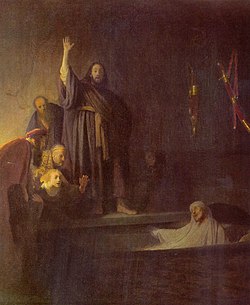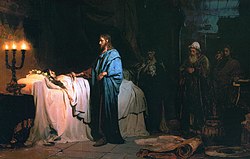Raising of the Dead: Difference between revisions
No edit summary |
No edit summary |
||
| Line 1: | Line 1: | ||
[[File:Rembrandt Harmensz. van Rijn 015.jpg|thumb|250px|[[w:The Raising of Lazarus (Rembrandt)|The Raising of Lazarus]], 1630–1631, [[w:Rembrandt van Rijn|Rembrandt van Rijn]] ([[w:Los Angeles County Museum of Art|Los Angeles County Museum of Art]])]] | [[File:Rembrandt Harmensz. van Rijn 015.jpg|thumb|250px|[[w:The Raising of Lazarus (Rembrandt)|The Raising of Lazarus]], 1630–1631, [[w:Rembrandt van Rijn|Rembrandt van Rijn]] ([[w:Los Angeles County Museum of Art|Los Angeles County Museum of Art]])]] | ||
[[File:Ilja Jefimowitsch Repin 013.jpg|thumb|250px|[[w:Ilya Repin|Ilya Repin]], The Reawakening of the Daughter of | [[File:Ilja Jefimowitsch Repin 013.jpg|thumb|250px|[[w:Ilya Repin|Ilya Repin]], The Reawakening of the Daughter of Jairus (1871)]] | ||
[[File:Aufweckung-Jüngling-Nain-15.jpg|thumb|250px|Resurrection of the Widow's son from Nain, altar panel by [[w:Lucas Cranach the Younger|Lucas Cranach the Younger]], c. 1569, in the [[w:Wittenberg|Stadtkirche Wittenberg]].]] | [[File:Aufweckung-Jüngling-Nain-15.jpg|thumb|250px|Resurrection of the Widow's son from Nain, altar panel by [[w:Lucas Cranach the Younger|Lucas Cranach the Younger]], c. 1569, in the [[w:Wittenberg|Stadtkirche Wittenberg]].]] | ||
| Line 16: | Line 16: | ||
And in each case the Christ must raise up a certain personality, a human soul, which is called by its destiny to be the special bearer of this germ of culture from ancient times, and which is at the same time that soul which can see to it that what the Christ has brought to humanity as gifts is also continued, that the understanding of the Christ and his mission can also be taught to humanity in later times in the appropriate way.|264|227f}} | And in each case the Christ must raise up a certain personality, a human soul, which is called by its destiny to be the special bearer of this germ of culture from ancient times, and which is at the same time that soul which can see to it that what the Christ has brought to humanity as gifts is also continued, that the understanding of the Christ and his mission can also be taught to humanity in later times in the appropriate way.|264|227f}} | ||
== Awakening reports in the Bible == | |||
=== New Testament === | |||
The following awakenings from death are mentioned in the [[Gospel]]s: | |||
* The raising or healing of Jairus' little daughter, reported in all three Synoptic Gospels: {{B|Mark|5:35-43}}, {{B|Matthew|9:23-26}} and {{B|Luke|8:49-56}} ([[Ancient Indian culture]]). | |||
* The raising of [[Lazarus]] of Bethany, who according to Rudolf Steiner became the favourite disciple of the Christ and is identical with [[John the Evangelist]]: {{B|John|11:1-45}} ([[Ancient Persian culture]]). | |||
* The raising of the [[young man of Nain]], who was later reborn as [[Mani]] and then as [[Parzival]]: {{B|Luke|7:11-17}} ([[Egyptian-Chaldean culture]]). | |||
Raising from the sleep of death was systematically cultivated in many pre-Christian schools of [[initiation]], for example in the [[Egyptian Mysteries]]. The [[initiate]] was put into a death-like state for three days, during which the [[etheric body]] and the [[astral body]] were lifted as far as possible out of the [[physical body]] and remained connected to it only by the thin [[silver cord]] mentioned above. In this way, the spiritual experiences that the initiate had in the out-of-body state could be imaged unhindered in the etheric body and the initiate could report on his experiences after his awakening. | |||
The awakenings of the dead by the Christ, which are described in the [[w:New Testament|New Testament]], are also to be understood as such initiation ceremonies, which, however, were not systematically brought about within a mystery community, but directly by the fate of the world. This is the case, for example, with the awakening of Lazarus: | |||
{{GZ|During the initiation, as described in the Gospel of John, the astral body leaves the physical body together with the etheric body. The latter then remains behind as in death. This is the basis for the description that Lazarus lay in the grave for three days. The miracle of Lazarus is therefore the image of an initiation. It is about bringing the astral and etheric body back into the physical body. This is done by the Master. The human being is now an awakened one who can remember the experiences in the higher worlds.|94|203}} | |||
The resurrected [[Lazarus]] thus became the beloved disciple, who was able to bear witness of his initiatory experiences in the [[Gospel of John]]. | |||
== Literature == | == Literature == | ||
Revision as of 14:24, 8 July 2021



The raising of the dead or awakening of the dead (Greek: εγειρω egeiro "to wake up, to raise, to erect"), which is often mistakenly equated with resurrection, is possible under suitable circumstances within a period of about three days after death, provided that the physical body has not been irreparably destroyed and the etheric body has largely but not yet completely detached itself from the physical body and dispersed in the general etheric world. At least by a narrow band, often called the so-called silver cord or similar, the astral body must also still be connected with the physical body. This is also how it is described in a passage of the Old Testament, where it says:
„... because all must go to their eternal home, and the mourners will go about the streets; 6 before the silver cord is snapped, and the golden bowl is broken, and the pitcher is broken at the fountain, and the wheel broken at the cistern, 7 and the dust returns to the earth as it was, and the breath returns to God who gave it.“
Through the raising of the dead, unlike the resurrection, the dead person returns to his original mortal body. So by raising the dead, death is by no means finally defeated.
In the New Testament three awakenings of the dead are described, with which at the same time the spirit of the three cultural epochs that preceded the [[Greco-Latin period is reawakened in a renewed form:
„In the Gospel of Matthew we are told how from the Orient come the three magi who offer their frankincense, their gold and their myrrh to the newborn infant Jesus, the reincarnated Zarathustra. They pay homage to their re-embodied Master who has worked in his various incarnations in the three preceding cultural epochs. They are, as it were, the keepers of the ancient wisdom treasures from the ancient Indian, the ancient Persian and the Egyptian-Babylonian epochs. And by laying these at the feet of the infant Jesus in the symbolic form of incense, gold and myrrh, they point out, as it were, how what has worked as cultural germs in these periods can only be saved for humanity if it is permeated by the Christ-power that will one day animate this infant. They themselves will no longer experience this resurrection of the wisdom treasures of their cultural epochs. "They went back to their country by another way".
But we can ask ourselves the question: Where do these three wise men remain later, what actually becomes of their wisdom? And we must remember that the cultures that arise and pass away here on Earth contain within them a seed that can be fertilised by the Christ Impulse and that will come to flower again in the periods of time that follow the Mystery of Golgotha. What the three magi from the Orient sacrificed as cultural germs to the infant Jesus will be raised up by the Christ; this contains the forces which can really permeate these three later cultural periods with the Christ Impulse. The third post-Atlantean age, in all that it contained as wisdom, will be raised up by the Christ, so that it can fertilise our fifth age. The second age, that of Zarathustra, is being awakened so that in the sixth post-Atlantean age the true understanding of the Christ can be there. And the first, the ancient Indian age, experiences its resurrection in the seventh post-Atlantean age with the help of the Christ-power.
And in each case the Christ must raise up a certain personality, a human soul, which is called by its destiny to be the special bearer of this germ of culture from ancient times, and which is at the same time that soul which can see to it that what the Christ has brought to humanity as gifts is also continued, that the understanding of the Christ and his mission can also be taught to humanity in later times in the appropriate way.“ (Lit.:GA 264, p. 227f)
Awakening reports in the Bible
New Testament
The following awakenings from death are mentioned in the Gospels:
- The raising or healing of Jairus' little daughter, reported in all three Synoptic Gospels: Mark 5:35–43, Matthew 9:23–26 and Luke 8:49–56 (Ancient Indian culture).
- The raising of Lazarus of Bethany, who according to Rudolf Steiner became the favourite disciple of the Christ and is identical with John the Evangelist: John 11:1–45 (Ancient Persian culture).
- The raising of the young man of Nain, who was later reborn as Mani and then as Parzival: Luke 7:11–17 (Egyptian-Chaldean culture).
Raising from the sleep of death was systematically cultivated in many pre-Christian schools of initiation, for example in the Egyptian Mysteries. The initiate was put into a death-like state for three days, during which the etheric body and the astral body were lifted as far as possible out of the physical body and remained connected to it only by the thin silver cord mentioned above. In this way, the spiritual experiences that the initiate had in the out-of-body state could be imaged unhindered in the etheric body and the initiate could report on his experiences after his awakening.
The awakenings of the dead by the Christ, which are described in the New Testament, are also to be understood as such initiation ceremonies, which, however, were not systematically brought about within a mystery community, but directly by the fate of the world. This is the case, for example, with the awakening of Lazarus:
„During the initiation, as described in the Gospel of John, the astral body leaves the physical body together with the etheric body. The latter then remains behind as in death. This is the basis for the description that Lazarus lay in the grave for three days. The miracle of Lazarus is therefore the image of an initiation. It is about bringing the astral and etheric body back into the physical body. This is done by the Master. The human being is now an awakened one who can remember the experiences in the higher worlds.“ (Lit.:GA 94, p. 203)
The resurrected Lazarus thus became the beloved disciple, who was able to bear witness of his initiatory experiences in the Gospel of John.
Literature
- Rudolf Steiner: Kosmogonie, GA 94 (2001) English: rsarchive.org German: pdf pdf(2) html mobi epub archive.org
- Rudolf Steiner: Zur Geschichte und aus den Inhalten der ersten Abteilung der Esoterischen Schule 1904 bis 1914, GA 264 (1987), ISBN 3-7274-2650-0 English: rsarchive.org German: pdf pdf(2) html mobi epub archive.org
 |
References to the work of Rudolf Steiner follow Rudolf Steiner's Collected Works (CW or GA), Rudolf Steiner Verlag, Dornach/Switzerland, unless otherwise stated.
Email: verlag@steinerverlag.com URL: www.steinerverlag.com. Index to the Complete Works of Rudolf Steiner - Aelzina Books A complete list by Volume Number and a full list of known English translations you may also find at Rudolf Steiner's Collected Works Rudolf Steiner Archive - The largest online collection of Rudolf Steiner's books, lectures and articles in English. Rudolf Steiner Audio - Recorded and Read by Dale Brunsvold steinerbooks.org - Anthroposophic Press Inc. (USA) Rudolf Steiner Handbook - Christian Karl's proven standard work for orientation in Rudolf Steiner's Collected Works for free download as PDF. |
